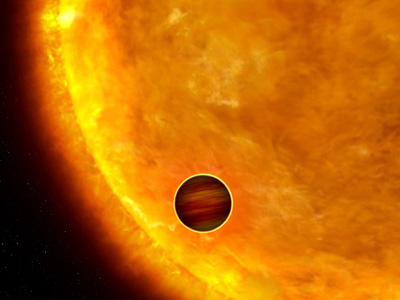The Tel Aviv University Mitzpe Ramon telescope also helped in the discovery of a planet outside the solar system

A planet's transit across its sun. Figure: European Space Agency
The European Space Agency's COROT space telescope, operated by French scientists, has discovered a hot planet, larger than Jupiter, as it passes by a distant star. The spacecraft launched on December 27 last year is the first designed to locate Earth-like planets in other solar systems.
COROT scientists say that the discovery of a planet this early in the telescope's operation is above and beyond their pre-launch expectations. The new planet is called Corot-exo-1b and it lies 1,500 light-years away in the direction of the Unicorn group.
The COROT space telescope hunts for planets by monitoring stars in an attempt to detect tiny changes in brightness as a result of the object passing in front of them.
The instruments on board the satellite, which weigh only 650 kg, are so sensitive that they are able to detect rocky planets, which are only a few times larger than Earth. The telescope looks towards a field of stars for days, and will continue to do so for the next two and a half years. According to the plan, he will observe 100 stars in the hope of finding more worlds that allow life to exist.
Dr. Susan Aigrain, co-investigator and expert on exoplanets from the University of Exeter in the UK, was delighted that the telescope had discovered an exoplanet so early after launch. According to her, the discovered planet is similar in basic structure to Jupiter, but larger - its mass is 1.3 Jupiter masses and its radius is 1.5-1.8 times larger. It orbits a sun similar to ours, but at such a close distance that it completes its coffee every day and a half.
Tel Aviv University's telescope at Mitzpe Ramon helped discover a planet
An international team of astronomers announced this week the discovery of a new planet outside the solar system, 400 light years away from Earth. Researchers from Tel Aviv University also participated in the international team. The discovery was made with the help of measurements made using a network of three identical small telescopes located in Hawaii, Arizona and Israel.
The discovery of the planet, which orbits the parent star 147509 HD, was made possible through the cooperation of the three stargazers, who together followed the star throughout the hours of the day. When the sun rose in Hawaii, the telescope in Israel, located at Tel Aviv University's Mitzpe Ramon Observatory, began to measure the light intensity of that star. Professor Zvi Maza from Tel Aviv University and PhD student Avi Shaforer from Tel Aviv University participated in the team.
The peculiarity of the new planet is that it hides a small part of its parent star, a situation identical to that in which a solar eclipse occurs. Today there are two hundred known planets outside the solar system, but only 14 of them form an eclipse and hide their parent star.

3 תגובות
Science has discovered 200 planets orbiting other suns
But the fact that most of them are the size of Jupiter and orbit their star every few days (very hot) does not teach us anything about
life in the galaxy except for the simple fact that this is the maximum image that the most modern telescopes can see
As of today .
The future telescopes will give us a completely different picture
on other solar systems so the problem is actually with us
(drawing early conclusions)
If there is water flowing on other stars, then it is unique in every respect. To my father: A truly impressive discovery is the discovery of a star that is likely to have life on it at a distance of 1-4 light years. At these distances, we can transmit messages about our location if we expect to receive an answer in a reasonable time.
From our tiny spot on the earth, which in the past was considered the center of the universe; A completely different picture is becoming clearer; that the life on earth is only a representative model of an infinite life, in an infinite universe; when the distances between the lives that exist on unique planets are almost infinite, in relation to and in the concepts of our finite existential sizes.